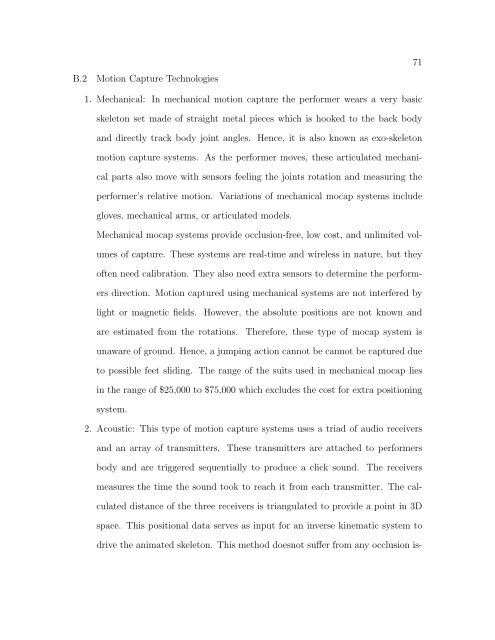A COMPARISON AND EVALUATION OF MOTION INDEXING ...
A COMPARISON AND EVALUATION OF MOTION INDEXING ...
A COMPARISON AND EVALUATION OF MOTION INDEXING ...
You also want an ePaper? Increase the reach of your titles
YUMPU automatically turns print PDFs into web optimized ePapers that Google loves.
B.2 Motion Capture Technologies<br />
1. Mechanical: In mechanical motion capture the performer wears a very basic<br />
skeleton set made of straight metal pieces which is hooked to the back body<br />
and directly track body joint angles. Hence, it is also known as exo-skeleton<br />
motion capture systems. As the performer moves, these articulated mechani-<br />
cal parts also move with sensors feeling the joints rotation and measuring the<br />
performer’s relative motion. Variations of mechanical mocap systems include<br />
gloves, mechanical arms, or articulated models.<br />
Mechanical mocap systems provide occlusion-free, low cost, and unlimited vol-<br />
umes of capture. These systems are real-time and wireless in nature, but they<br />
often need calibration. They also need extra sensors to determine the perform-<br />
ers direction. Motion captured using mechanical systems are not interfered by<br />
light or magnetic fields. However, the absolute positions are not known and<br />
are estimated from the rotations. Therefore, these type of mocap system is<br />
unaware of ground. Hence, a jumping action cannot be cannot be captured due<br />
to possible feet sliding. The range of the suits used in mechanical mocap lies<br />
in the range of $25,000 to $75,000 which excludes the cost for extra positioning<br />
system.<br />
2. Acoustic: This type of motion capture systems uses a triad of audio receivers<br />
and an array of transmitters. These transmitters are attached to performers<br />
body and are triggered sequentially to produce a click sound. The receivers<br />
measures the time the sound took to reach it from each transmitter. The cal-<br />
culated distance of the three receivers is triangulated to provide a point in 3D<br />
space. This positional data serves as input for an inverse kinematic system to<br />
drive the animated skeleton. This method doesnot suffer from any occlusion is-<br />
71
















